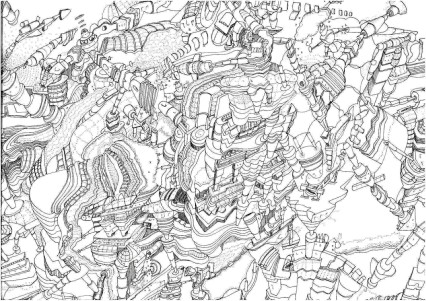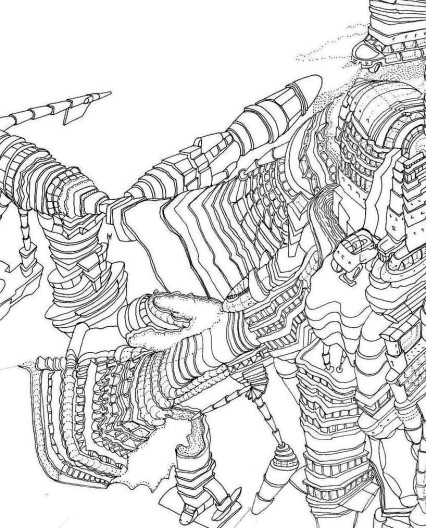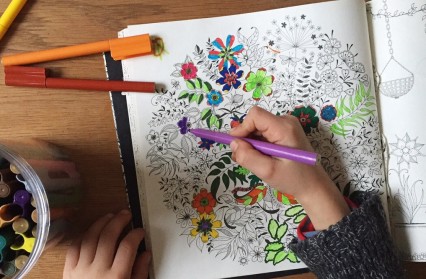Richard Porch offers his analytical take on the increasingly popular worldwide trend of adult colouring books.
If you’ve been into a book shop of any size recently you can’t fail to have noticed a section devoted to the colouring book. The humble activity of colouring in the blank spaces between proscribed lines that we all did in our childhood has been reinvented as a fashionable hobby for grown-ups. And a lucrative sideline for publishers. The hobby has caught on in a big way especially in the USA and France where they are an industry within an industry.
 What also catches the eye about them is how poverty-stricken most of them are in terms of content. In looking at any number of them it is clear they are just recycling old line drawings that were originally generated for something else. The publishers have been quick to ‘repurpose’ these for the newly-fashionable adults colouring book market.
What also catches the eye about them is how poverty-stricken most of them are in terms of content. In looking at any number of them it is clear they are just recycling old line drawings that were originally generated for something else. The publishers have been quick to ‘repurpose’ these for the newly-fashionable adults colouring book market.
This is why the subject matter looks very similar to the kind you’d see in a children’s colouring book, which is disappointing. For the adult’s market they merely add a sexier jacket while the interior would still appeal as much to a child as their parent. A small number of the more upmarket publishers offer purpose-designed pages by ‘proper’ illustrators and these are themed; i.e. cities of the world, adventure and so on. Which is good.
 I’d have thought there was a real market for high-quality artwork as opposed to mere graphics. Simply blocking in fields of colour to line illustrations culled from the children’s equivalent of clip art is lowest common denominator stuff. They should be commissioning artists to design colouring books the like of which they’ll have never seen before. Pages of imagery that shake-up the imagination and force the user (whether child or adult) to engage with what they are colouring-in. Rather than simply slavishly fill in colour to already proscribed designs. Why not introduce pages of random imagery to which the user has to bring order by laying down colour? Or is that asking too much? The user supplies the organising discipline and vision; in so doing form emerges from disorder and they contribute to the creative process. Anything has to be better than simply and slavishly just adding colour to something of moronic simplicity. I’m only surprised that more artists haven’t been drafted in to add an extra dimension. Actually I’m not; it would cost more to commission them and their art has nothing to do with these things. The commercial imperative to cash in on the craze while it still has some mileage (or put another way – money) overpowers any need for originality.
I’d have thought there was a real market for high-quality artwork as opposed to mere graphics. Simply blocking in fields of colour to line illustrations culled from the children’s equivalent of clip art is lowest common denominator stuff. They should be commissioning artists to design colouring books the like of which they’ll have never seen before. Pages of imagery that shake-up the imagination and force the user (whether child or adult) to engage with what they are colouring-in. Rather than simply slavishly fill in colour to already proscribed designs. Why not introduce pages of random imagery to which the user has to bring order by laying down colour? Or is that asking too much? The user supplies the organising discipline and vision; in so doing form emerges from disorder and they contribute to the creative process. Anything has to be better than simply and slavishly just adding colour to something of moronic simplicity. I’m only surprised that more artists haven’t been drafted in to add an extra dimension. Actually I’m not; it would cost more to commission them and their art has nothing to do with these things. The commercial imperative to cash in on the craze while it still has some mileage (or put another way – money) overpowers any need for originality.
Being a fan of cities I’ve produced some designs for imaginary cityscapes that might make good colouring-in subject matter. Although I think they are probably a bit too neurotically overdrawn or non-realistic to appeal to the average buyer of colouring-in books (adult or otherwise). Nevertheless, they make a call on the person colouring them in that hopefully goes beyond merely substituting coloured space for white space. They leave room for the user to bring something to the exercise and in doing so make the proposition a partnership.
Richard Porch is a regular contributor at Wales Arts Review.
Inset drawings by Richard Porch











